-

人教版高中英语必修4Women of achievement说课稿4篇
Good morning, distinguished judges:It’s my honor to talk about my teaching ideas with you. Today my topic is Women of Achievement. My presentation consists of six parts: the analysis of teaching material and student, teaching aims, key and difficult points, teaching and studying method, teaching procedures and blackboard design.First, let’s focus on the analysis of teaching material. This lesson is from New Senior English for China Student’s Book 4 Unit 1, the reading part. The main topic of the passage is the introduction of a student of Africanwildlife. After this lesson, the students will learn more information about her studying chimps in Africa, and their reading and speaking abilities can be developed as well.The next part is the analysis of students. My students are in senior high students. They have learnt English for many years, they’ve known many words and sentences, but their speaking and reading abilities are still not very good. So I will practice their speaking and reading abilities through different exercises.According to the New Standard Curriculum and the present situation, I set the teaching aims as follows: firstly, knowledge aims. Students can grasp some new words, such as worthwhile, move off. Moreover, students can understand the content of the passage and get familiar with the topic of studying chimps in wildlife. Secondly, ability aims. Students can use reading strategies such as skimming and scanning in reading process. Thirdly, emotional aims. Students can have the awareness of protecting animals and care about animals.Based on the above analysis, the key point of this lesson is to get the main idea and the detailed information from the passage; the difficult point is to talk about the wildlife protection and use reading strategies.

人教版高中英语必修3Festivals around the World说课稿3篇
Teaching plan for Unit 1 book3Good morning, teachers. It’s my great pleasure to be here because I can share my lesson with you and I can learn a lot from it. I’ll begin my lesson from the following four parts, the teaching material, the teaching methods, the studying methods and the teaching procedure.Firstly, let me talk about the teaching material. The content of my lesson is the reading passage festivals and celebrations of Unit 1 Festivals around the world. This passage is about festivals and celebrations. By studying this passage, we’ll enable the students to know that festivals exit everywhere, and many of festivals in different countries celebrate similar ideas. As we all know, the reading passage is the center of each unit. If the Ss can learn it well, it will be helpful to make the Ss learn the rest of this unit.After studying the teaching material, I think the teaching aims are as the followings:1. Knowledge aims:(1) The Ss can master the usage of the important words andexpressions.(2)The Ss can use the __________________ (grammar) in the proper situation.Make students know about the festivals all over the world and the detail of the festivals, such as origin, content, and the date of the holiday festivals.2. Ability aims:(1) Students can talk about festivals and celebrations in English(2) To improve the student’s reading ability, especially their skimming and scanning ability.3. Emotion aims:Make the Ss know about the foreign festivals, and respect other countries’ custom.Next, let’s come to the important points and the difficult points.The important point is how to make the Ss understand the text better and the difficult point is how can they talk about it. secondly, Teaching Methods:1. task-based Language Teaching2. Computer assisted language teaching.3. question-and–answer methodThirdly, Studying Methods:

人教版高中英语必修4Theme parks说课稿3篇
The oldest and the most popular park in the worldenjoy the exciting activities thereget close to the life-size cartoon characters like Mickey Mouse and Donald Duck Step 3 Pre-reading1.What do you suppose a theme park is ?2.What do you think you can see in a theme park?(1.It is a kind of amusement park which has a certain theme – that the whole park is based on. 2.buildings, castles, statues, rare animals and birds, and so on.) Step 4 Reading ----- Theme Parks –---- Fun and More Than Fun1.Predict : Read the title and the pictures on P. 34 and PredictWhat is the meaning of the title “Theme Park – Fun and more than fun”?(The title means that theme parks are fun to visit, but that they can also be educational and can offer useful information.)2.Skimming Fast read and answer:What activities can we take in a theme park?Amusement park: Bumper car Merry-go-round slide bungee jumping Free-fall rides Horror films Pirate ship Ferris wheel roller coaster3.Scanning Read again and you will find various theme parks are mentioned in the passage . Then what are they ?Theme parks: Sports theme park History theme park Culture theme park Marine or Ocean theme Park Future park Science theme park Disneyland4.Careful reading and find the main idea of each paragraph:THEME PARKS---- entertaining/ educationalPara.1 Traditional parks are places to go for relaxation and to have time away from our busy lives.Para.2 Theme parks are different They’re large and full of things to do, see and buy.Para.3 Theme parks are built around a single idea or theme. One example is a sports park.Para.4 Another kind of theme park is historical more and cultural and can be educational.Para.5 Disneylandwas the first theme park. It is based on the fantasy life and characters of Disney’s films.Para.6 Some examples of educational theme parks include sea world parks and science parks.

人教版高中英语必修3Healthy Eating说课稿4篇
Language learning needs a context, which can help the learners to understand the language and then can product comprehensible output, so computer has the advantages to make the materials attractive.Part 3 Learning MethodsTask-based, self-dependent and cooperative learningPart 4 Teaching ProcedureStep One Lead-in“Interest is the best teacher.” Therefore, at the very beginning of the class, I should spark the students’ mind to focus on the centre topic “the band”. I’ll show some pictures of food to attract their attention and then bring some questions.Question:What kind of food they like?What should go into a good meal?The answers must relate to the diet. After this, the students will be eager to know something about a balance diet and this is the very time to naturally lead the class into Step 2Step 2 Reading for information: skimming and scanning In this step, I use Task-based Language Teaching method, which can give students a clear and specific purpose while skimming and scanning the context.Task 1 General ideaThe students will be asked to just glance at the title and the pictures of the passage, and then guess what they will read in the text. And they’ll be divided into groups of four to have a discussion.The purpose is to inspire the students to read actively, not passively. In addition, the task is to develop the students’ reading skill by making prediction and to encourage the students to express their thoughts in English and cooperate with each other.Task 2 Main idea of each paragraphCooperative learning can raise the students’ interest and create an atmosphere of achievement. Based on this theory, I divide the whole class into 4 groups to skim the whole text and get the main idea of each paragraph.

人教版高中英语必修4Working The Land说课稿3篇
Knowledge objectives:(1) to make Ss grasp the usage of words, expressions and sentence structures: statistics, struggle, thanks to, rid of, some patterns for persuasion, the “ing” form as subject and object;(2)to use learnt knowledge to persuade sb.Ability objectives:(1) to develop Ss’ reading skills(skimming, scanning, word guessing);(2) to improve Ss’ speaking, communicating and cooperating skills.Emotional objectives:to make Ss know the contribution of Yuan,and learn his spirit and his simple life time.Teaching important and difficult points:(1) some words, expressions and sentence structures mentioned above;(2)the content of the text;(3)training their reading and speaking skills.Teaching methods: CLT, TBLT,QT.Learning strategies: CLS, QLS, TBLS.Teaching procedures:Step 1 lead-in: (1) teacher plays a piece of recent news from CCTV about the harvest of the super hybrid rice, and ask students whether they know Yuan or not, and talk about him and his contribution.(2)Brain storm: let Ss describe Yuan in their minds including his appearance, his living condition and so on.Step 2 fast reading tasks:(1)teacher introduces Yuan and super hybrid rice(2)make Ss read the text as fast as possible with questions. Such as: what’s the general ideaof this passage? What’s Yuan’ dream? (skimming and scanning skill)Step 3 intensive reading tasks(1)let Ss read the text silently, find topic sentence of each paragraph and draw the difficult sentences and the knowledge what they don’t understand.(words guessing)(2)teacher and Ss talk about the important words, expressions and sentences together, and ask Ss to retell the content of the text.(summarizing and paraphrasing)(3)teacher summarize this part.(4) read again following the courseware.

人教版高中英语必修3The million pound bank note说课稿3篇
在接下来的细读环节,我套用了高考对阅读理解的考查方式设置了5个问题,分别为三个推理判断题,一个细节题和一个主旨大意题。学生需要对文章的内容进行分析、归纳、推理、猜测等高级思维活动才能做出正确的回答。【设计意图】这一过程是对学生进行细读的训练,培养学生获取特定信息和挖掘文章深层次信息的能力。第三环节:Intensive-reading (精读) 15′第三个环节精读,既是最重要的环节,也是突破本课重难点的关键。首先,让学生思考剧本中人物看到百万英镑前后的态度发生了怎样的变化。其次,让学生仔细阅读文章,找出可以表现人物态度变化的具体的语言和动作。最后,让学生总结人物的态度发生变化的根本原因是什么,从而引出Money Talks, 供学生思考。【设计意图】通过一系列的活动培养学生学习从人物的语言和动作探究人物的心理,使学生进一步体会戏剧语言的魅力,从而对文章背后所反映的社会问题进行思考,也为下一步的讨论环节做好铺垫。
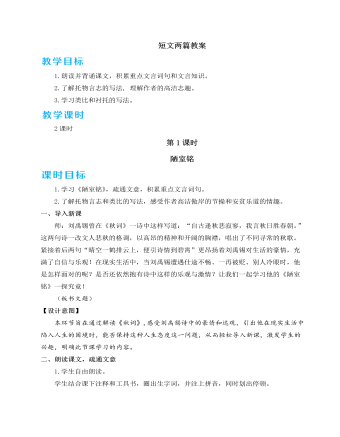
人教部编版七年级下册短文两篇教案
本课由两篇短小易懂、文辞优美的文言文组成,针对这一特点,本课设计分为两课时,先通过教读《陋室铭》学习托物言志,再通过自主学习《爱莲说》来理解托物言志,采用先教后学的模式进行教学。在《陋室铭》教学中,设计“朗读”“品读”“析读”“联读”四个环节,逐层深入,在读中明特点,读中明志趣,读中析写法,读中悟主旨。以诗人积极的人生态度、豁达的胸襟为行文线索,从文本出发,深入解读文本,让学生逐步理解诗人面对苦难仍能坚守自我的人生态度和高尚情操,同时让学生学习托物言志的手法,了解这类文章的特点。《爱莲说》采取自主学习的模式,分两步进行。先运用上节课的四个环节,在老师的指导下,进行自主合作学习。老师给予学生自学方法,并适时引导,让学生逐步完成学习任务,以此理解文章内容,提高学生自主学习文言文的能力;再采用竞赛的方式展示学习成果,以几个不同形式的比赛,来激发学生的学习兴趣,让学生在竞赛中夯实文言文的基础知识,在竞赛中加深对文章的理解,学会探究。本课整个教学设计思路清晰,教学方法可操作性强。

人教部编版语文八年级上册短文二篇教案
陶弘景隐居茅山时期,仍然关心社会的发展,希望社会稳定,天下百姓都能安居乐业。梁武帝很感激陶弘景给予的有力支持,亲提御毫,写了一封情真意切的御诏,文曰:“山中何所有?卿何恋而不返?”盼望陶弘景出山辅政,重列朝班。然而陶弘景下定了不出山的决心,他先写了一首诗,后画了一幅画作为回答。诗为《诏问山中何所有赋诗以答》:“山中何所有,岭上多白云。只可自怡悦,不堪持赠君。”画的内容是:两头牛,一头散放水草之间,自由自在;一头套着金笼头,被人用牛绳牵着,用牛鞭驱赶。梁武帝看了诗和画,领会了他的用意,就不再强迫他出来做官了。但是“国家每有吉凶征讨大事,无不前以咨询”,故当时人称陶弘景为“山中宰相”。林语堂《苏东坡传》中这样评价苏轼
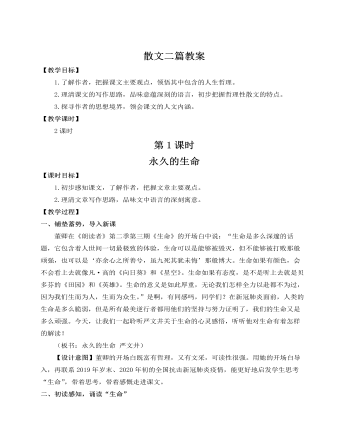
人教部编版语文八年级上册散文二篇教案
师:既然活得这么痛苦,为什么罗素说是“值得”的?预设 (1)罗素胸怀广阔,勇于担当,要为解除天下百姓的苦难而活着,因此付出辛苦是值得的;(2)罗素不以苦为苦,而以苦为乐,因此痛苦的生活是值得的;(3)苦中伴随着乐,例如爱情会带来欢愉,同时征服了苦难也会产生胜利的喜悦,因此苦乐相伴的体验是值得的;(4)虽然罗素最终没能减轻人类的不幸,甚至自己也深受其害,但毕竟努力过,奋斗过,这一切都是值得的。2.思维拓展师:像罗素一样心忧天下的人还有很多,你想到了谁?课件出示:屈原:长太息以掩涕兮,哀民生之多艰。杜甫:安得广厦千万间,大庇天下寒士俱欢颜!范仲淹:先天下之忧而忧,后天下之乐而乐。阿诺德:“同情,使软弱的人觉得这个世界温柔,使坚强的人觉得这个世界高尚。”……师小结:罗素追求爱情、知识、同情心,作为中学生的我们更应该有自己的追求。我们的追求要有利于社会的发展,要符合社会的进步要求,这样,我们的追求才会更有意义。【设计意图】设计此环节,一是为了深化对本文的理解,二是让学生思维拓展延伸,联想更多与罗素类似同情人类苦难的人,培养学生正确的人生观,用榜样去影响学生。【板书设计】
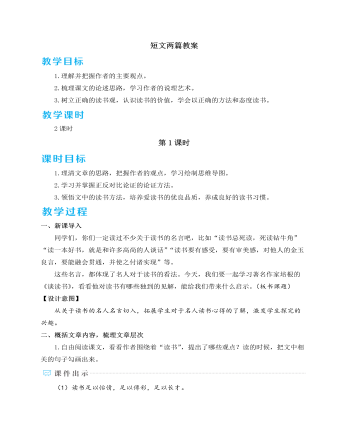
人教部编版语文九年级下册短文两篇教案
一、新课导入同学们,你们一定读过不少关于读书的名言吧,比如“读书忌死读,死读钻牛角”“读一本好书,就是和许多高尚的人谈话”“读书要有感受,要有审美感,对他人的金玉良言,要能融会贯通,并使之付诸实现”等。 这些名言,都体现了名人对于读书的看法。今天,我们要一起学习著名作家培根的《谈读书》,看看他对读书有哪些独到的见解,能给我们带来什么启示。(板书课题)【设计意图】从关于读书的名人名言切入,拓展学生对于名人读书心得的了解,激发学生探究的兴趣。二、概括文章内容,梳理文章层次1.自由阅读课文,看看作者围绕着“读书”,提出了哪些观点?读的时候,把文中相关的句子勾画出来。(1)读书足以怡情,足以傅彩,足以长才。(2)读书时不可存心诘难作者,不可尽信书上所言,亦不可只为寻章摘句,而应推敲细思。(3)书有可浅尝者,有可吞食者,少数则须咀嚼消化。(4)读书使人充实,讨论使人机智,作文使人准确。(5)读史使人明智,读诗使人灵秀,数学使人周密,科学使人深刻,伦理学使人庄重,逻辑修辞之学使人善辩:凡有所学,皆成性格。
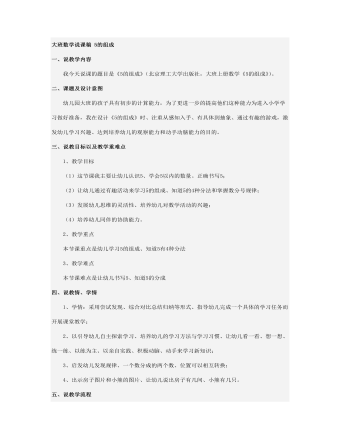
大班数学说课稿 5的组成
幼儿园大班的孩子具有初步的计算能力,为了更进一步的提高他们这种能力为进入小学学习做好准备,我在设计《5的组成》时、注重从感知入手、有具体到抽象、通过有趣的游戏,激发幼儿学习兴趣、达到培养幼儿的观察能力和动手动脑能力的目的。 1、教学目标 (1)这节课我主要让幼儿认识5、学会5以内的数量。正确书写5; (2)让幼儿通过有趣活动来学习5的组成、知道5的4种分法和掌握数分号规律; (3)发展幼儿思维的灵活性、培养幼儿对数学活动的兴趣; (4)培养幼儿同伴的协助能力。 2、教学重点 本节课重点是幼儿学习5的组成、知道5有4种分法 3、教学难点 本节课难点是让幼儿书写5、知道5的分成
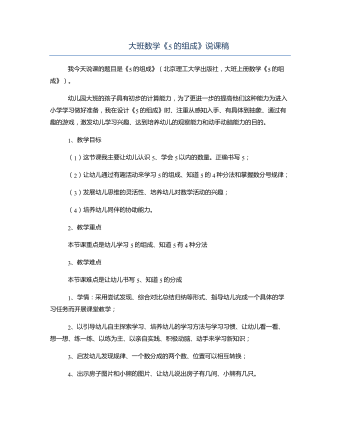
大班数学《5的组成》说课稿
我今天说课的题目是《5的组成》(北京理工大学出版社,大班上册数学《5的组成》)。幼儿园大班的孩子具有初步的计算能力,为了更进一步的提高他们这种能力为进入小学学习做好准备,我在设计《5的组成》时、注重从感知入手、有具体到抽象、通过有趣的游戏,激发幼儿学习兴趣、达到培养幼儿的观察能力和动手动脑能力的目的。1、教学目标(1)这节课我主要让幼儿认识5、学会5以内的数量。正确书写5;(2)让幼儿通过有趣活动来学习5的组成、知道5的4种分法和掌握数分号规律;(3)发展幼儿思维的灵活性、培养幼儿对数学活动的兴趣;(4)培养幼儿同伴的协助能力。
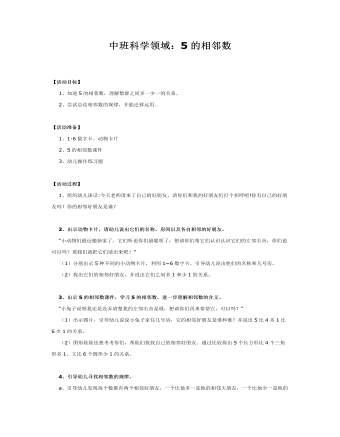
中班数学教案:5的相邻数
【活动准备】 1、1-6数字卡、动物卡片 2、5的相邻数课件 3、幼儿操作练习题 【活动过程】 1、组织幼儿谈话:今天老师请来了自己的好朋友,请你们和我的好朋友们打个招呼吧!你有自己的好朋友吗?你的相邻好朋友是谁? 2、出示动物卡片,请幼儿说出它们的名称、房间以及各自相邻的好朋友。 “小动物们最近搬新家了,它们听说你们最聪明了,想请你们帮它们认识认识它们的左邻右舍,你们说可以吗?那我们就把它们请出来吧!” (1)分别出示5种不同的小动物卡片,利用1~6数字卡,引导幼儿说出他们的名称和几号房。
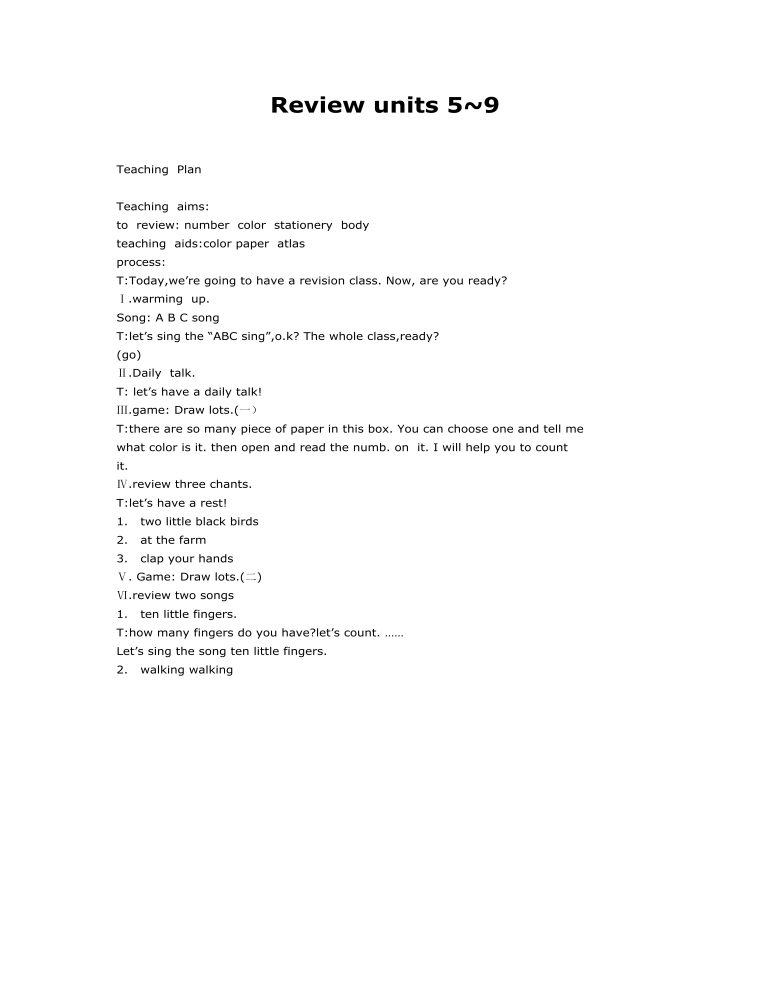
大班英语教案:Review units 5~9
T:Today,we’re going to have a revision class. Now, are you ready?Ⅰ.warming up.Song: A B C songT:let’s sing the “ABC sing”,o.k? The wholeclass,ready?(go)Ⅱ.Daily talk.T: let’s have a daily talk!Ⅲ.game:Draw lots.(一)T:there are so many piece of paper in this box.You can choose one and tell me what color is it. then open and read the numb.on it. I will help you to count it.
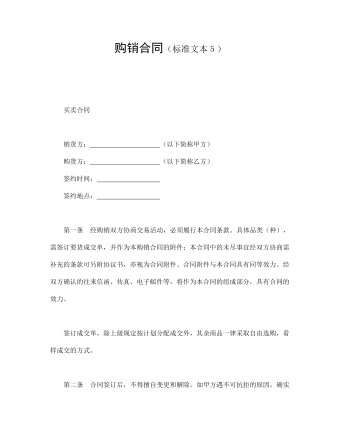
购销合同(标准文本5)
第一条 经购销双方协商交易活动,必须履行本合同条款。具体品类(种),需签订要货成交单,并作为本购销合同的附件;本合同中的未尽事宜经双方协商需补充的条款可另附协议书,亦视为合同附件。合同附件与本合同具有同等效力。经双方确认的往来信函、传真、电子邮件等,将作为本合同的组成部分,具有合同的效力。 签订成交单,除上级规定按计划分配成交外,其余商品一律采取自由选购,看样成交的方式。 第二条 合同签订后,不得擅自变更和解除。如甲方遇不可抗拒的原因,确实无法履行合同;乙方因市场发生骤变或不能防止的原因,经双方协商同意后,可予变更或解除合同。但提出方应提前通知对方,并将“合同变更通知单”寄给对方,办理变更或解除合同的手续。 按乙方指定花色、品种、规格生产的商品,在安排生产后,双方都需严格执行合同。如需变更,由此而产生的损失,乙方负担;如甲方不能按期、按质、按量按指定要求履行合同,其损失,甲方负担。
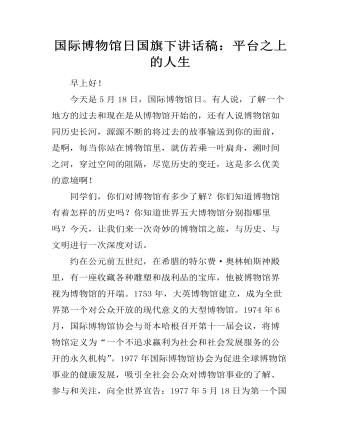
国际博物馆日国旗下讲话稿:平台之上的人生
早上好!今天是5月18日,国际博物馆日。有人说,了解一个地方的过去和现在是从博物馆开始的,还有人说博物馆如同历史长河,源源不断的将过去的故事输送到你的面前,是啊,每当你站在博物馆里,就仿若乘一叶扁舟,溯时间之河,穿过空间的阻隔,尽览历史的变迁,这是多么优美的意境啊!同学们,你们对博物馆有多少了解?你们知道博物馆有着怎样的历史吗?你知道世界五大博物馆分别指哪里吗?今天,让我们来一次奇妙的博物馆之旅,与历史、与文明进行一次深度对话。约在公元前五世纪,在希腊的特尔费·奥林帕斯神殿里,有一座收藏各种雕塑和战利品的宝库,他被博物馆界视为博物馆的开端。1753年,大英博物馆建立,成为全世界第一个对公众开放的现代意义的大型博物馆。1974年6月,国际博物馆协会与哥本哈根召开第十一届会议,将博物馆定义为“一个不追求赢利为社会和社会发展服务的公开的永久机构”。1977年国际博物馆协会为促进全球博物馆事业的健康发展,吸引全社会公众对博物馆事业的了解、参与和关注,向全世界宣告:1977年5月18日为第一个国际博物馆日,并每年为国际博物馆日确定活动主题,XX年的主题是:博物馆致力于社会的可持续发展。而法国的卢浮宫,英国的大不列颠博物馆,美国的大都会博物馆,俄罗斯的艾米塔什博物馆,中国的故宫博物馆位列世界五大博物馆行列。
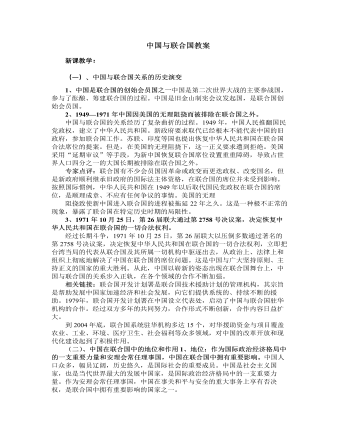
人教版高中政治选修3中国与联合国教案
(2)、中国坚持以互利合作实现共同繁荣----促进共同发展中国坚持以互利合作实现共同繁荣。中国连续担任经社理事会理事国,积极参与经社系统有关经济和社会发展的重要国际会议和其他活动并承办了联合国第四次世界妇女大会。中国积极推动南北对话和南南合作,敦促发达国家为实现全球普遍、协调、均衡发展承担更多责任。中国加人多项国际人权公约并认真履行公约义务,与联合国人权事务高级专员保持良好合作,与多国展开人权对话。相关链接:1995年9月,联合国第四次世界妇女大会在北京举行。来自197个国家和地区以及众多国际组织的1.76万名代表围绕会议主题“以行动谋求平等、发展与和平”展开热烈讨论。会议通过了《北京宣言》和《行动纲领》,为全球妇女事业的发展注入了新的活力。
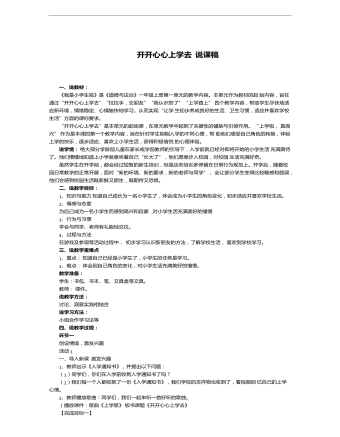
开开心心上学去 说课稿
一、说教材:《我是小学生啦》是《道德与法治》一年级上册第一单元的教学内容。本单元作为教材的起始内容,旨在通过“开开心心上学去”“拉拉手,交朋友”“我认识您了”“上学路上”四个教学内容,帮助学生尽快地适应新环境,情绪稳定、心情愉快地学习。从而实现“让学生初步养成良好的生活、卫生习惯,适应并喜欢学校生活”方面的课标要求。“开开心心上学去”是本单元的起始课,在单元教学中起到了关键性的铺垫与引领作用。“上学啦,真高兴”作为是本课的第一个教学内容,旨在针对学生刚刚入学的不同心理,帮助他们感受自己角色的转换,体验上学的快乐,逐步适应、喜欢上小学生活,获得积极愉悦的心理体验。说学情:绝大部分学龄前儿童在家长或学前教师的引导下,入学前就已经对即将开始的小学生活充满期待了。他们懵懂地知道上小学就意味着自己“长大了”,他们愿意步入校园,对校园生活充满好奇。虽然学生在开学前,都会经过短暂的新生培训,但是这些培训多停留在日常行为规范上。开学后,随着校园日常教学的正常开展,面对“新的环境、新的要求,新的老师与同学”,会让部分学生变得比较敏感和脆弱,他们会感到校园生活既新鲜又陌生,既期待又恐惧。二、说教学目标:1、知识与能力知道自己成长为一名小学生了,体会成为小学生的角色变化,初步适应并喜欢学校生活。2、情感与态度为自己成为一名小学生而感到高兴和自豪 ,对小学生活充满美好的憧憬3、行为与习惯学会与同学、老师有礼貌地交往。4、过程与方法在游戏及参观等活动过程中,初步学习认识新朋友的方法,了解学校生活,喜欢到学校学习。

“心连心”进敬老院之行-说课稿
尊敬的各位评委老师:大家好!我叫刘丽萍 ,来自安岳县思贤乡中心小学,是一名四年级的中队辅导员。?今天我说课的主题是:心连心,送温暖;关爱老人,从我做起。【活动背景】?敬老爱老是中华民族的传统美德,每个人都会老,步入老年之后,年迈体弱,孤独多病,甚至生活不能自理的他们,应得到我们及社会的关爱和帮助,身为青少年的我们,关爱老年朋友,更是义不容辞的。?我们要让孤寡老人们感受到社会对他们的关怀,同时增强同学们的社会责任感,让大家了解社会,关注这群庞大而特殊的群体,从中学会关爱,学会感恩,弘扬中华民族敬老爱老的传统美德。?我们思贤中心小学少先大队计划了一次“心连心”走进敬老院,关爱老人的活动。希望通过这次的活动不但能够给老人们送去关爱,送去温暖,同时也能起到锻炼学生,增加学生社会知识的作用。【活动目的】本节课要达到三个活动目标:1.丰富敬老院老人的生活,给他们精神上的满足2.增强学生与老人的沟通能力,懂得关心亲人3.通过活动锻炼同学之间的团结合作能力【活动准备】1.与敬老院有关负责人取得联系,与其洽谈具体的时间和相关事宜。2.统计所有参加活动的人,并交代注意事项3.准备好慰问品:自制的小礼品
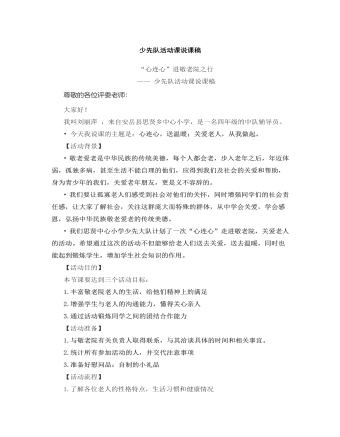
“心连心”进敬老院之行说课稿
1.集合必须准时。出返程中一定得注意安全,不得出现打闹杂乱现象,着装整洁。2.进入敬老院,见到老人一定要微笑打招呼,这是对老人的一种尊重与认可。3.与老人交谈时要尽量的去倾听他们,要引导老人多讲述他们的往事。4.老年人多患有心脑血管疾病,活动时应注意不可有太大响声,不可长时间吵闹起哄,尽量避免老人较大的活动及情绪波动,以避免老人出现身体不适。5.老年人在敬老院多存在孤独寂寞感,交流时语言必须亲切。由于代沟严重,老年人的许多生活习惯及言谈话题与小学生当下习惯有较大不同,务必时刻保持“有兴趣”*清扫房间时一定要将物品放回原处,不要改变它们的原来布局。【活动后期】1.报道此次活动的流程及意义。2.做好记录,大队辅导员负责储存资料及照片。3.与教育局沟通,发表通讯稿及照片,推广此次活动,让各班级明白此次活动的意义。






